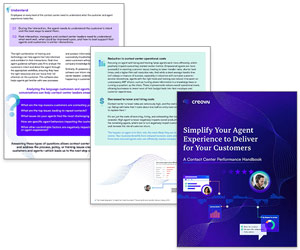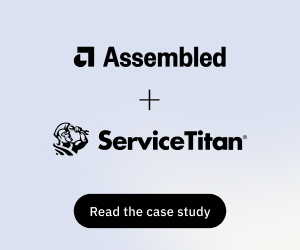Continuous improvement is energy.
It’s the energy that drives organizations forward – making things better for customers and employees alike. But that energy doesn’t just exist… It has to be created!
To do this, you need the right mix of people, processes, and technology – with a clear path from idea to impact.
So how do you get started? We asked Paul Pember, Founder of CX Score, to explain how the very best contact centre leaders make it happen…
10 Secrets to Creating a Culture of Continuous Improvement
1. Incentivize High Performers AND Those With High Potential
(Yes – They’re Not Always the Same People)
Wait… Someone who isn’t a top performer gets to drive improvement?
Absolutely. Here’s why…
When I was a supporter care advisor at Cancer Research UK, I wasn’t a high performer. Not even average, really. But I constantly asked why.
- “Why are we doing it like this?”
- “Why don’t we try something different?”
A senior manager saw potential and gave me a couple of days to test an idea. That idea redesigned our invalid cheques process – preventing over £250,000 per year from being unnecessarily returned to supporters.
Sometimes your most valuable improvement energy comes from unexpected places, so give people a couple of hours a week to explore ideas.
You’ll create a flywheel of engagement, inspiration, and capability.
For advice on incorporating creative and motivational incentives, read our article: 100 Great Staff Incentives to Motivate Your Team
2. Deliver Something – Anything – Early
(Or People Will Stop Believing)
This is where most initiatives stall.
You launch a campaign, encourage ideas… But nothing happens. Momentum slips. People go back to thinking “nothing really changes around here”.
You’ve got to deliver. Even small wins count – especially in the early days. Show progress. Show impact.
3. Don’t Just Make Things “Less Bad”
(Try Eliminating the Problem Altogether)
Improvement isn’t always about marginal gains.
Sometimes, it’s about stepping back and asking, “Should we even be doing this in the first place?”
If the answer is no, shift your focus. Stop trying to improve the broken thing and find a way to stop it from happening in the first place.
That’s what I did with the invalid cheques. I didn’t just make the process more efficient – I designed it out entirely!
If you are looking for a starting point to address classic broken processes in the contact centre, read our article: Key Signs of Broken Processes (and How to Fix Them)
4. Make It Everyone’s Job
(Not Just Top-Down. Not Just Bottom-Up. All Directions.)
If you want continuous improvement to be more than a fad, it has to be everyone’s business.
Everyone brings a different lens. Involving all roles and levels creates a shared sense of ownership and a powerful message: everyone counts, and every voice matters.
This is how you create a movement. This is how culture changes.
5. Design Your Improvement Approach
(Don’t Wing It)
Map the journey from idea to execution. Visualize it. Co-design it with your people. Test and adapt as you learn.
Ask yourself:
- How will ideas be submitted?
- Who reviews them?
- How do we test ideas fast?
- What support is needed to move from idea to action?
If the process is clunky, slow, or unclear – improvement won’t stick.
6. Launch a 1% Improvement Campaign
(The Compound Effect Is Real)
If you improve by 1% a week, that’s over 67% better by the end of the year.
Start quietly. Deliver a few early wins behind the scenes. Then showcase what’s possible – and invite others to join in.
1% feels achievable. Accessible. Universal.
Some of my favourite improvements are tiny; for example:
A dropdown menu where the most common option was at the bottom. It took 5 extra seconds each time. Multiply that by 24 uses/day, 200 days, 100 advisors… And that equates to 670 hours saved – or 0.33 FTE!
7. Set the Tone From Day One
(Build It Into Onboarding)
Continuous improvement doesn’t just emerge. You need to nurture it – and that starts as soon as someone joins the team.
Set expectations. Share examples. Do a hands-on activity. Bring in a peer who’s made an impact to share their story.
If you embed the mindset early, people will carry it forward.
For advice on getting your onboarding off to the right start, read our article: 21 Top Tips to Improve Your Agent Onboarding
8. Don’t Wait for an All-Singing-All-Dancing Solution to Get Started
It’s 2025 – you don’t need expensive tech.
Use what you’ve got: a CRM form, intranet page, or even SurveyMonkey.
Make it easy!
9. Build a Prioritization Framework
Not every idea needs a business case. Some just need to be done. Others need more planning.
A framework helps you decide what moves forward – and how.
10. Make Someone Accountable
If no one owns it, nothing will happen.
You need:
- A senior manager accountable for the overall design and success
- Team leaders and managers responsible for enabling and embedding it
- Advisors responsible for becoming advocates (peer-to-peer encouragement is far more impactful)
Even More Ideas We’ve Spotted Out and About
That’s not all! Here are some great examples our Editor – Megan Jones – has spotted out and about on our Call Centre Helper site visits on how to nurture a culture of continuous improvement in your contact centre…
Encourage Agents to Say “What’s Working” in Team Huddles
At Ocado, all agents are encouraged to use their team huddle as an opportunity to share examples of customer conversations and talk through common objections. For example, sharing, “I say this……… when the customer says this………….”.
Done regularly, this can nurture a safe space for open and honest conversations, where agents feel confident to talk through any issues and learn from each other, as well as take advice from their team manager.
Help Your Team Pitch Their Ideas to the Wider Business
Pitching ideas to the wider business requires a level of skill that can be a barrier to innovation for those that don’t have these refined communication skills.
At Bupa, managers take proactive steps to address this by supporting their colleagues in communicating their ideas – from condensing ideas to help make them clearer, supporting with presentation skills, making sure any materials are on brand, and making introductions to relevant people to help get the idea off the ground.
If you are looking for advice on improving internal contact centre communication, read our article: How to Improve Internal Communication in the Contact Centre
Always Use the Word ‘Trial’ When Rolling Out New Initiatives
When rolling out a new initiative, the management team at Leeds Building Society always refer to it as a ‘trial’. That way it becomes a test for everyone, encouraging feedback and allowing space for learning.
The ‘trial’ creates a safety net and more confidence in trying out new initiatives – making it clear to colleagues that it’s an experiment (not a guaranteed fixture) and giving leaders more breathing room for rolling back ideas if they don’t work out as initially hoped.
Constantly Benchmark to Make Sure You’re the Best
As the idiom goes, “don’t rest on your laurels”. The Specsavers team are constantly benchmarking themselves against other businesses and taking proactive steps to ensure they remain an employer of choice in the local area – particularly as Nottingham is a call centre hub with fierce competition for the best staff!
Nurture a Culture of Psychological Safety to Get the Best Out of Your Teams
Do your agents feel safe enough to share their ideas? You really need to work on this if they don’t!
The leadership team at Simplyhealth focus on nurturing a workspace of psychological safety, where agents feel safe to express their thoughts, take risks, and make mistakes without fear of humiliation. It’s a win–win for continuous improvement!
Turn Ideas Into Impact – Every Day!

Creating a culture of continuous improvement isn’t about grand gestures! It’s about building momentum through consistent, deliberate action!
These initiatives aren’t quick fixes either. They’re mindset shifts – all helping to make sure that improvement becomes part of your daily rhythm.
After all, when it stops being a project and starts being part of your culture… That’s when the real transformation begins!
Written by: Paul Pember, Founder of CX Score
If you are looking for more ways to improve your contact centre, read these articles next:
- How to Define Career Paths in Your Contact Centre
- 10 Inspiring Spots to Host Your Next Team Meeting
- 9 Ways to Create a Thriving Contact Centre Culture
Author: Paul Pember
Reviewed by: Jo Robinson
Published On: 30th Jun 2025 - Last modified: 15th Sep 2025
Read more about - Call Centre Management, Culture, Employee Engagement, Incentives, Leadership, Management Strategies, Paul Pember, Team Management, Top Story







































